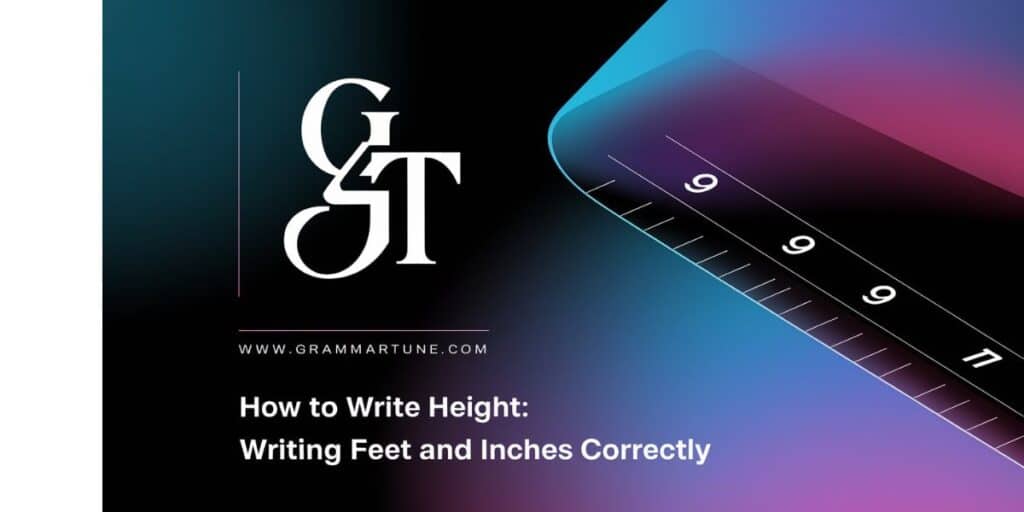Proper writing of writing height: writing in feet and inches clearly matters. This is necessary for formal documents, research papers, and casual scripts. Right format makes an appearance in the text.
Numerals, symbols, and abbreviations aid in the accurate writing of height. Should it be “5 feet 10 inches” or “5’10”? Therefore, the consistent placement of measurement references depends upon uniform writing rules.
This guideline includes recommendations regarding proper set-up, some common pitfalls, and a cheat sheet on “how-tos” in terms of writing feet and inches properly. Such clean and professional standards of writing aid in enhancing environments.
📌 Table of Contents
📝 Understanding Height Formatting
✅ How Do You Write Height in Feet and Inches Correctly?
✅ Chicago Manual of Style Guide 📖
✅ Associated Press (AP) Style Guide 📰
✅ ASME, MLA, APA Style Guide 🏛️
✅ Abbreviations of Height in Feet and Inches ✍️
✅ Abbreviation of Feet and Inches 📏
✅ Using Primes for Feet and Inches 🔢
✅ Writing Height Proceeding a Noun 📌
📐 Practical Usage & Examples
✅ Examples of How to Write Height 🏆
✅ Feet and Inches Abbreviations 📎
✅ Prime and Double Prime 🔹🔸
✅ The Last Word on How to Write Height ✨
✅ Write Dimensions in Foot 📐
✅ Foot or Feet? ❓
✅ Write Dimensions in Other Length Units 📏
✅ Write Dimensions in Area Units 🌍
✅ Volume Units ⚖️
✅ Weight Units 🏋️
✅ Exercises & Answers ✍️
How Do You Write Height in Feet and Inches Correctly?
The writing height in feet and inches is an important factor in consistency and clarity. Words, symbols, or abbreviations may be used, depending on the context.
For example, ‘5 feet 10 inches’ is the even version, while ‘5’10” is common in informal writing. Always follow the example set by whatever format of writing you are currently using. Proper use makes for legibility and professionalism.
Some might say you’ve got a writing height of 5 feet 10 inches, and others might say that 5’10” is how you should write it. Both are correct, just used in different contexts.
It is, however, best to follow the writing style that you’re in. That way, there would be proper use, and one could enjoy easy-to-read, professional standards when writing.
For formal settings, write out the measurements, while numerals should be used in technical or casual writing. Inconsistencies, especially in mixed units, should be double-checked. Remove any unnecessary or mistaken periods or spacing.
Must read: Quit vs Resign: Clear Up the Confusion Once and For All
Chicago Manual of Style Guide
From a formal perspective, measurements should be spelled out according to the Chicago Manual of Style. For example, in nontechnical use, the expression would be, “five feet ten inches.”
When writing numbers in formal text, the words should follow numerals as in “5 feet 10 inches.” Use of symbols such as an apostrophe should be avoided.
Keep consistent in formatting when all heights are named. That would mean she is “five feet two inches tall and he is six feet three inches.” This is important for clarity in professional and academic writing and for the maintenance of uniformity.
Associated Press (AP) Style Guide
The use of numerals to designate heights in feet and inches is prescribed by the new AP Style Manual. Correctly stated, “He is 5 feet 10 inches tall
When it appears before a noun, hyphenation should be used (“a 5-foot-10-inch player”). Do not use quotes or the prime symbol.
The headquarters of AP style is clarity and readability, and the heights measured in feet and inches should keep this clarity in any sort of journalistic writing.
ASME, MLA, APA Style Guide
Several guides have distinctive regulations concerning writing heights in feet and inches: The APA style is numeral, for instance, “5 ft 10 in.”; the MLA would write it out; according to ASME guidelines, it should use the abbreviations. Each makes his way clear in his way.
It all relies on your audience, what guide to follow. Most papers that are academic would generally spell numbers in prose but use numerals on technical papers. Writing in the proper format can greatly enhance accuracy and professionalism in different disciplines.
Abbreviations of Height in Feet and Inches
For height measurement in feet and inches, keep it simple. The standard abbreviation for feet is “ft,” and for inches, it’s “in.” For example, he is 5 ft 10 in tall.
Some branches of technology use symbols instead of abbreviations. The prime symbol (‘) denotes feet, while the double prime (“) denotes inches. So, always look up the formatting rules of the document or publication you are writing for.
The standard abbreviation is “ft” for feet and “in” for inches. He is 5 ft 10 in tall. Needed only if your style guide prescribes such a practice. Some technical fields prefer symbols rather than abbreviations.
In these instances, use the prime symbol (‘) for feet and the double prime (“) for inches. Always check the formatting rules of the document or publication you are writing for.
Foot and inch height are really as simple as that. He is 5 ft 10 in tall.’ Some would even prefer the use of symbols rather than such abbreviations. Always double- check the formatting rules of writing according to the document or publication.
Abbreviation of Feet and Inches
Standard abbreviations guarantee clear measurement attributes. Clearly, the abbreviation for feet in measurements would be “ft,” and inches has “in.”
The numeric values followed directly by these abbreviated forms should be without any punctuation; for example, “6 ft 2 in.”
Always follow the particular style guide in business documents. Consistent formatting also renders measurement more easily readable and understandable.
Using Primes for Feet and Inches
Quotes (‘) and double quotes (“) provide a rapid method for indicating height in feet and inches. For example, “5 ’10”” is a common informality.
Technical and engineering realms prefer primes for the sake of brevity. Formal writing generally avoids them. Use these symbols consistently, and readability will follow across formats.
Writing Height Preceding a Noun
When height in feet and inches appears before a noun, hyphenation is necessary. For example: a 6-foot-2-inch runner is the right way to say it. Hyphens clarify things and stop misreading.
Don’t use symbols or abbreviations in front of a noun but rather spell out the measurement. plea, “a 6-foot-2-inch runner” is the correct format. The hyphens ensure clarity and prevent misreading.
Avoid using symbols or abbreviations before a noun. Instead, write out the measurement fully. This rule applies to journalistic, academic, and professional writing styles.
Examples of How to Write Height
For example, in casual conversation, the expression “He’s 5’9″” works well; while a more formal writing would favor the use of “He is 5 feet 9 inches tall
” Which expression to use depends on which style manual you consult. Therefore, it is always important to tailor the form according to the writing style format in order to promote clarity and professionalism.
Feet and Inches Abbreviations
The typical abbreviations for feet and inches include the symbols “ft” and “in,” which should be used in formal and technical writing. Avoid any unnecessary use of punctuation, retaining “5 ft. 10 in.” only where the style guide prescribes it.
The apostrophe and quotation mark are informal shorthand. Always check required style guidelines to avoid incoherence in your document.
You will like: Mouses vs Mice: What’s the Correct Plural of Mouse?
Prime and Double Prime
Typically, these symbols are not used in formal writing; instead, either the full term “feet” or “inches” is written or the standard abbreviations are used. Be sure to check with style guidelines for your specific situation.
The Last Word on How to Write Height
Formats for writing height in feet and inches vary according to the context and the style manual being adhered to.
Consistent usage of whichever form, abbreviation, numeral, or word, is necessary. Following the style manual will retain clarity and professionalism. Always verify the format you have chosen for accuracy.
Write Dimensions in Foot
Numbers follow foot for dimensions expressed in foot. For instance, “The table is 6 ft long.” In technical writing, one might find “6’0″ for six feet. For instance, Harry, who plays football for the United States, is 19 years of age and is 6’0” tall.
For clarity, adhere to the style guide. “Feet” in formal writing, while blueprints or engineering documents may use “6’0” in prime symbols.
Foot or Feet?
“Foot” refers to a singular value, while “feet” refers to a plural value. But, “foot” will appear in compound adjectives like: “6-foot ladder.” Use him according to the grammatical context of the sentence.
Write Dimensions in Other Length Units
In addition to feet and inches, many dimensions refer to meters, centimeters, or yards. For example, “A 10-meter bridge” or “A 3-yard piece of fabric” has the proper notation. It depends on the local standards.
Write Dimensions in Area Units
Be careful about hyphenation in compound adjectives: a 500-square-foot house is correct, while a 500 square feet house is not.
Volume Units
Cubic feet (cu ft), liters (L) or gallons (gal) are typical units in which volume is expressed. For example, “The pool holds 1,000 gallons of water.”
Technical writing may abbreviate them, but everyday usage spells them out. Always follow the appropriate style guide for whatever is clear.
Weight Units
Weight is usually measured in pounds (lb), kilograms (kg), or tons. For instance: “The box weighs 50 lb” or “A suitcase weighing 25 kg.”
Avoid unnecessary abbreviations in formal writing, unless required. “50 lbs” is acceptable in informal settings, while “50 pounds” is more formal.
Exercise 1
Convert the following measurement into different units:
A room is 12 feet long and 10 feet wide. Express this in meters.
ANSWER
12 feet = 3.66 meters, 10 feet = 3.05 meters.
The room is 3.66 meters long and 3.05 meters wide.
Exercise 2
Write the correct format for 5 feet 6 inches using abbreviations.
ANSWER
5 ft 6 in (formal) or 5’6″ (informal).
Exercise 3
Rephrase the following sentence:
“The yard is twenty feet wide and forty feet long.”
ANSWER
The yard is 20 feet wide and 40 feet long.
Exercise 4
Which is the correct form?
a) He is 6 foot tall.
b) He is 6 feet tall.
ANSWER
b) He is 6 feet tall.
Exercise 5
Convert the following to square feet:
A garden is 4 yards by 3 yards.
ANSWER
1 yard = 3 feet.
4 yards × 3 yards = 12 feet × 9 feet = 108 square feet.
You will like: High Quality or High-Quality: Which One Is Correct?
FAQ’S
How do you correctly write height in feet and inches?
Write height in feet and inches using numerals followed by the full words, abbreviations, or prime symbols. Examples:
- Formal: “He is 5 feet 9 inches tall.”
- Abbreviated: “He is 5 ft 9 in tall.”
- Symbolic: “He is 5’9″.”
Should I use “foot” or “feet” when writing dimensions?
Use “foot” in compound adjectives (e.g., “a 6-foot table”). Use “feet” when stating measurements alone (e.g., “The room is 10 feet wide”).
What is the correct abbreviation for feet and inches?
- Feet = ft
- Inches = in
- Example: “He is 5 ft 10 in tall.” Avoid using unnecessary periods unless required by a style guide.
Can I use prime symbols (’ and ”) for feet and inches?
Yes, but only in informal or technical contexts. For example, 5’10” is acceptable in casual writing, while 5 ft 10 in is preferred in formal documents.
How do I write dimensions for an object in feet and inches?
List width, height, and depth in order. Examples:
- Furniture: “The table is 6 feet long, 3 feet wide, and 2.5 feet high.”
- Blueprints: “The window is 4’0″ x 6’8″.”
How do different style guides handle height and dimensions?
- Numbers less than 10 should be spelled out in Chicago’s Manual of Style, e.g., “five feet ten inches.”
- According to AP Style, where numerals must be used, spell out the unit: “He is 5 feet 10 inches tall.”
- APA & MLA refer to numerals with abbreviations; examples include “5 ft 10 in”.
What are the correct ways to write area and volume measurements?
- Area: square units, such as “500 square feet” (abbreviated: 500 sq ft).
- For volume: cubic units such as “1,000 cubic feet” (1,000 cu ft).
Conclusion
Mastering How to Write Height: Writing Feet and Inches Correctly ensures clarity and professionalism. Consistency should apply to all representations, whether used in words, abbreviations, or symbols.
In formal writing, one would spell out, for instance, “5 feet 10 inches,” while informal contexts accept “5’10″”. Follow the style manual standards, say AP, Chicago, or APA, to avoid blunders in measurement formatting.
Always choose the one unit representation that serves the purpose of readability and accuracy. Following these best practices in the representation of height measurement communicates these measurements whatsoever, making your writing clear, precise, and professional in any context.

Joulia, a seasoned wordsmith and grammar enthusiast, brings over a decade of blogging expertise to Grammar Tune. With a keen eye for linguistic precision and a passion for making complex grammar concepts accessible, he has helped thousands of readers enhance their writing skills. His engaging teaching style and practical approach to language learning have made him a trusted voice in the online grammar community.







